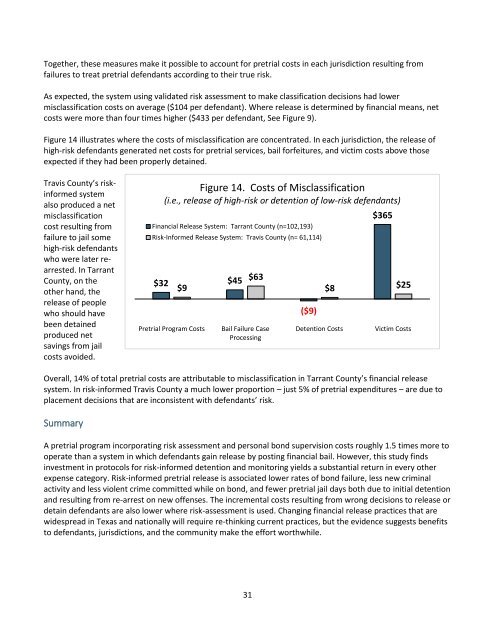LIBERTY AND JUSTICE PRETRIAL PRACTICES IN TEXAS
170308_bond-study-report
170308_bond-study-report
You also want an ePaper? Increase the reach of your titles
YUMPU automatically turns print PDFs into web optimized ePapers that Google loves.
Together, these measures make it possible to account for pretrial costs in each jurisdiction resulting from<br />
failures to treat pretrial defendants according to their true risk.<br />
As expected, the system using validated risk assessment to make classification decisions had lower<br />
misclassification costs on average ($104 per defendant). Where release is determined by financial means, net<br />
costs were more than four times higher ($433 per defendant, See Figure 9).<br />
Figure 14 illustrates where the costs of misclassification are concentrated. In each jurisdiction, the release of<br />
high-risk defendants generated net costs for pretrial services, bail forfeitures, and victim costs above those<br />
expected if they had been properly detained.<br />
Travis County’s riskinformed<br />
system<br />
also produced a net<br />
misclassification<br />
cost resulting from<br />
failure to jail some<br />
high-risk defendants<br />
who were later rearrested.<br />
In Tarrant<br />
County, on the<br />
other hand, the<br />
release of people<br />
who should have<br />
been detained<br />
produced net<br />
savings from jail<br />
costs avoided.<br />
Figure 14. Costs of Misclassification<br />
(i.e., release of high-risk or detention of low-risk defendants)<br />
Financial Release System: Tarrant County (n=102,193)<br />
Risk-Informed Release System: Travis County (n= 61,114)<br />
$32 $45<br />
$9<br />
Pretrial Program Costs<br />
$63<br />
Bail Failure Case<br />
Processing<br />
($9)<br />
Detention Costs<br />
$365<br />
$8 $25<br />
Victim Costs<br />
Overall, 14% of total pretrial costs are attributable to misclassification in Tarrant County’s financial release<br />
system. In risk-informed Travis County a much lower proportion – just 5% of pretrial expenditures – are due to<br />
placement decisions that are inconsistent with defendants’ risk.<br />
Summary<br />
A pretrial program incorporating risk assessment and personal bond supervision costs roughly 1.5 times more to<br />
operate than a system in which defendants gain release by posting financial bail. However, this study finds<br />
investment in protocols for risk-informed detention and monitoring yields a substantial return in every other<br />
expense category. Risk-informed pretrial release is associated lower rates of bond failure, less new criminal<br />
activity and less violent crime committed while on bond, and fewer pretrial jail days both due to initial detention<br />
and resulting from re-arrest on new offenses. The incremental costs resulting from wrong decisions to release or<br />
detain defendants are also lower where risk-assessment is used. Changing financial release practices that are<br />
widespread in Texas and nationally will require re-thinking current practices, but the evidence suggests benefits<br />
to defendants, jurisdictions, and the community make the effort worthwhile.<br />
31


